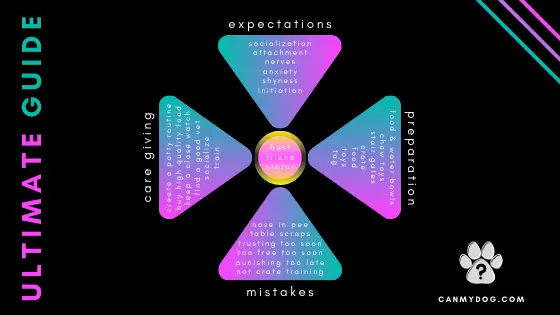
I think you all know me well enough by now to know that I’m the smartest dog you will ever have the privilege of reading from. I’m going to go out on a limb and say I’m the best dog writer in the world. This is why I wanted to take the time to comprehensively outline a guide for all of you nervous first time dog parents out there.
Put your helmet on, humans, it’s about to get rough, then better, then rough, then awesome.
Dive into the procedural and typically progressive components of what happens to a human when they become dog parents for the first time. From expectations all the way down to the inevitable mistakes – we’re going deep in this one.
I am not a doctor or a human psychiatrist (thank goodness because you guys are 12 shades of bananas). I can’t always help you with you problems but I’ll attempt to prepare you a bit in this guide.
If you leave this article feeling no more prepared than when an ant hill accidentally meets a dog paw, well then, I don’t accept responsibility for that either. That’s on you.
If you’re okay with that and ready, then by all means… Let’s get it.
Disclaimer: The Can My Dog articles contain information based on the individual research and opinions of the author of the site – who just so happens to be a dog. How you utilize the information given is completely up to you. Proceed at your own risk.
What to Expect as First Time Dog Parents

First and foremost, congratulations! You are about to embark, (ha ‘bark’), on one of the greatest experiences imaginable and accessible to humans today.
Good on you for making the decision to adopt a sweet puppy.
While us pups are notorious for bringing joy to our owners, I would be remiss, if not down right negligent, if I omitted the part about expectations.
So, lets start there.
Time and Attention
Dogs love attention. I can guarantee that most of your time in the beginning of this relationship will be spent in full blown interaction mode. We’re getting to know you and you’re getting to know us.
If you work crazy hours, actually, if you work at all, I would suggest you go ahead and schedule some PTO time in order to get a jump start on the puppy / human initiation process.
Anxious and Overwhelming
You and your puppy will both be overwhelmed for the first week. You’re throwing a wrench in your puppy’s normal spoke and he’s throwing a bag of rocks at your windshield.
Let me repeat: This initial transition is NOT an easy, streamlined, and optimized flow that interweaves perfectly into your life as you currently know it.
Quite the contrary.
For the Love of Peanut Butter, Go Slow
Do you have kids?
If so, make sure your kids understand that they may need to reel it in a notch in the beginning.
These tiny humans can be terrifying to a new puppy in a new environment. Allow an adaptive and progressive approach to your tennis balls to the wall kids and your new puppy.
This goes for you older adults too.
One of the best expectations I can give you is to have zero expectations. Play it by ear. Let everyone get to know everyone in the beginning of this new relational adaptation and move on from there – slowly.
Sh*t Happens
And I mean this very literally.
Make it a point to show your puppy where to use the bathroom immediately upon arriving to your home.
But do this in a natural way.
What do I mean?
Keep it simple. When you get to your house, before you go in, sit your puppy down on the grass. Let them sniff and walk around. Allow them time to pee and / or poop.
As soon as they’re finished, reinforce that action with some positive words of encouragement plus lots and lots of pets.
This will let your puppy know that pooping outside gets him loved on.
But please remember, you are dealing with a puppy. Much like a newborn, they will inevitably have accidents in the house and on the floor. Remain calm. It was just an accident. Take them outside as soon as this happens. Again, this just reinforces appropriate potty atmosphere.
Excitement Mixed with Fear
You can one-hundred percent expect to be excited beyond compare when you finally get to bring your puppy home. But rest assured that this will be coupled with extreme fear and partial panic.
Taking on the responsibility of raising a sweet puppy is not for the faint of heart.
Unfortunately, most people don’t realize this until it’s too late. I want you to know up front that raising a puppy is terrifying.
Preparation
Let me be very clear here.
Preparation is mission critical when it comes to the overall success and streamlined effectiveness of bringing your new puppy home.
Waiting until after your puppy is living with you is a horrible idea. Do not be a lazy human when it comes to due diligence and puppy prep.
If you revert back to the graphic I made for you guys up at the top, you’ll see the over-viewing list of essentials needed during this imperative preparation phase.
Let’s begin there.
Food and Water Bowls
This one is very near and dear to my heart. I love to eat and for some reason these little bowl things makes that so much more convenient for me.
I highly recommend you spend some time picking these out for your puppy.
Something I want to mention in this section though – consider what type of breed you’re adopting. Will your puppy grow into a massive mammoth of a dog?
If so, might I suggest investing in a food and water bowl stand that progressively adjusts in height over time.
You don’t want your pup straining his neck while he’s eating his food well into his adult life.
This is super uncomfortable for us. Take it from me, and I’m a short dude. The bowls should be chin level – always.
Food
If food and water bowls were important, this section is VITAL.
The type of food you choose to feed your dog from puppy stage on into older adult stages is vital to the over all well being and functional longevity of your good boy or girl.
You are what you eat. This is true for both humans and for your dogs.
Do. Not. Feed. Us. Cheap. Full. Of. Fillers. And. By-products. Dog. Food. Crap.
Read why you should actually be cooking for your dog.
Is good food a little more expensive?
Yes. But how much is our health and life ultimately worth to you?
I rest my case.
Chew Toys vs. Regular Toys
Yes, you need both.
Yes there is a difference.
Let’s start with chew toys. You’re going to need lots of these because guess what? Puppies chew. Like crazy. Don’t get aggravated with them though as this is essentially the same thing your human babies go through when they teethe. Their gums are sore and chewing on certain types of toys help soothe their puppy gums.
You know the rubber circle toy with the spiky nubby things all over it? Yeah, those type of chew toys are awesome for puppy babies to gnaw on. Rack up on these.
Now for the regular play toys. Get a rope toy. We love playing tug-of-war with you. It’s literally the best. But don’t leave your dog alone with any ropes. They’ll tear them apart and then maybe eat the strings. Not a good thing and can be terribly dangerous for your puppy.
Get some tennis balls – sized accordingly – based on the size of your puppy. They make tennis balls as small as golf balls and as large as soccer balls.
You humans are so innovative. Good on you.
As a matter of fact, balls of any kind are always a great dog toy idea. We can never have too many. Start there and work your way out and up within the dog toy sector.
As a matter of fact, I wrote a piece on the best teething toys for husky puppies. Let me be the first to say, if it’s good enough for a husky puppy, it’s good enough for any breed. Huskies are powerful chewers.
I’ll link it here. Check it out if you have the time.
ID Tag
This is fun to do.
You can go to a place like PetSmart or Walmart and they have a machine there where you can pick out the shape and color of the ID tag and type in the information you want engraved on the tag.
All for like 8 bucks.
Oh, or they also make these new cool ones that my Aunt Rigby has on her collar. I think Qalo makes them. I’ll link it below in the “What You Will Need” section for your reference.
Why do you need to go ahead and get the ID tag? Because time, that’s why. When you bring your puppy home, you’re going to see the convenience of running errands and time slip through your fingers like dry sand on a windy island.
Best to be proactive and have your pups tag and collar ready to slip on immediately.
One less thing you’ll have to worry with later on. Having your puppy’s identification tag ready for worst case scenarios can be a huge relief to you.
Crate
How do you feel about crate training?
Take if from me, a dog boy, crate time is a good thing. I know we may look sad and act like we don’t want to go in there but it actually makes us feel safe and secure.
Especially when you’re gone most of the day.
I would also like to note that this helps keep your puppy out of trouble. Don’t get me wrong though, I, nor my sister Callie has been put in a crate all day in years. We’re good babies and are able to be trusted alone these days. Especially me. Callie still likes to party when the parents leave for work sometimes.
Anyway, go ahead and purchase a crate that can grow as your puppy grows. This saves time and money in the long run while keeping things seemingly consistent for your puppy as he gets older.
Stair Gates
Safety first, humans.
Safety first.
Do not, I repeat, do NOT allow your new puppy to be left unattended on or around stairs in your home. Especially when your puppy is new to the home, and well, new to stairs.
Stairs are dangerous and proper precaution must be taken seriously.
Don’t wait until your puppy is home to remember to put up the stair gate. Go ahead and grab one now so that you’ll be prepared. Set it up on your way out to go pick up your puppy for the first time.
One less thing you’ll have to worry about.
In case you’re not picking up what I’m putting down here, I would just like to reiterate that preparation is key. It’s key to success in life and it’s key to puppy adoption success.
I digress, again.
Anyway, your puppy will get used to it being there, it won’t scare them and they’ll leave it alone. Eventually you will be able to remove this and allow your puppy access to the stairs, but not until they’re big enough.
Also, you don’t have to google the search term “dog stair gate”. A regular baby gate works the same – just a different breed of infant.
What You Will Need
I have given a comprehensive preparation overview in the section directly above – now I want to further streamline the process for you and link the things you need under this header for a one-stop-shop type of deal.
Food and Water Bowls
I highly recommend an adjustable feeder designed to hold both bowls – especially if you are getting a puppy that will grow quickly and is of a larger breed size.
Regardless, make sure that the food bowls are positioned at a height that when your pup is eating, his neck is relatively parallel to the ground and not in a downward stretched position.
- I use this one at my house. It’s pretty good. You can start here. Click this link to check the most recent price on Chewy.

Food
Dog food is a highly nuanced topic. So many opinions. So much misinformation out there. Wading through the lackluster advice and landing on the gold can be a daunting task for even the most diligent of you out there.
I wrote another post emphasizing the importance of dog food and primarily focused on the fresh homemade variation. I’ll link it here for your reference if you’re at all interested.
However, since you don’t know your puppy very well yet, and there’s a certain healthy testing phase encompassed in the first few weeks of your puppy’s diet, I would suggest you begin with the following options.
Disclaimer: Be sure to talk to your vet prior to bringing your puppy home to add their professional opinion to your research mix.
- Dry Puppy Food: Click here to check current pricing on Chewy
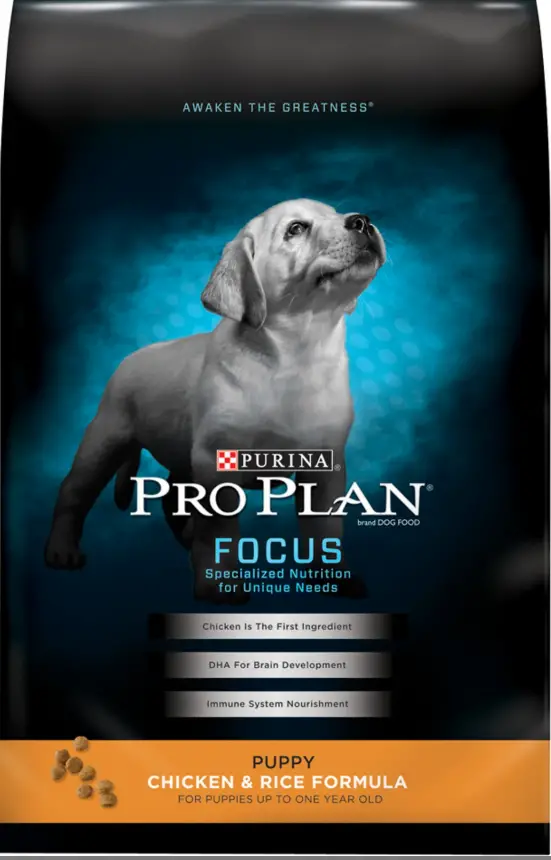
- Human Grade Puppy Food: Click here to check current pricing on Chewy

- Raw Puppy Food: Click here to check current pricing on Chewy
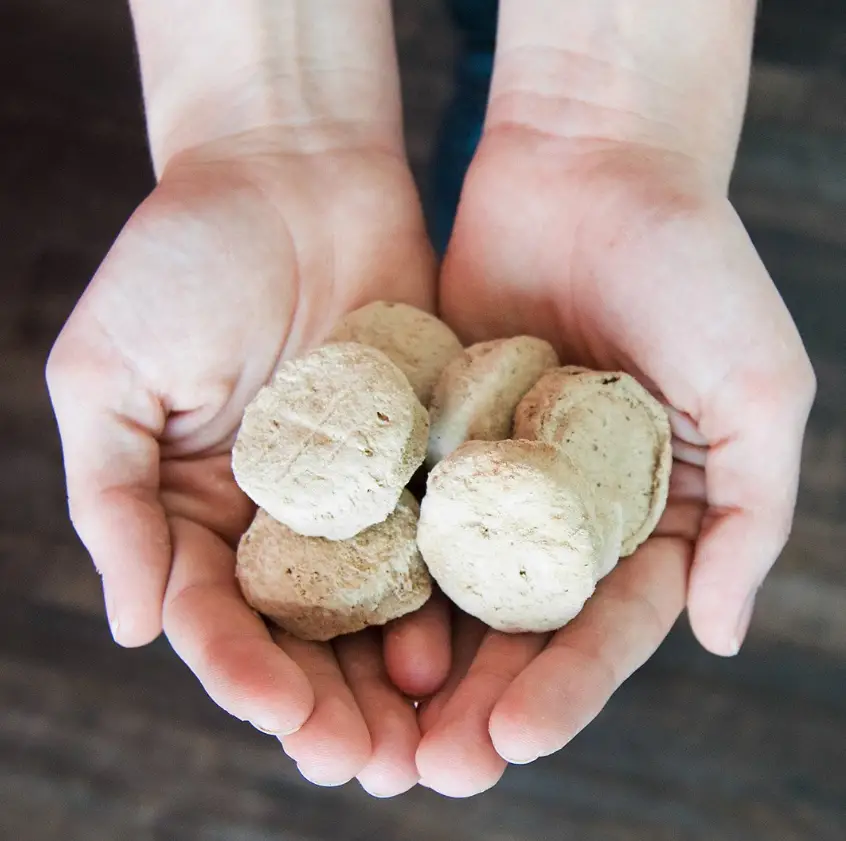
Chew Toys
If you don’t want your puppy’s first choice to be your new pair of shoes, then I highly recommend you get him a variety of chew toys and have them readily available all over the floor.
I know.
It’s messy. But not as messy as a kitchen table with a missing leg. This phase is obnoxious but temporary.
Start with some of these:
- You must get a Kong. Indestructible – for real, and varies in sizes so you can continue to upgrade as you puppy grows: Click this link to check the current pricing on Chewy

- Dental Chew Teething Bone. Super affordable. This thing is cute and also comes in various sizes: Click this link to check the current price on Chewy

- Another cool dental chew bone-thingy. Callie actually had one of these when she was a tiny husky puppy. She loved it. Affordable prices on these: Click this link to check the current price on Chewy
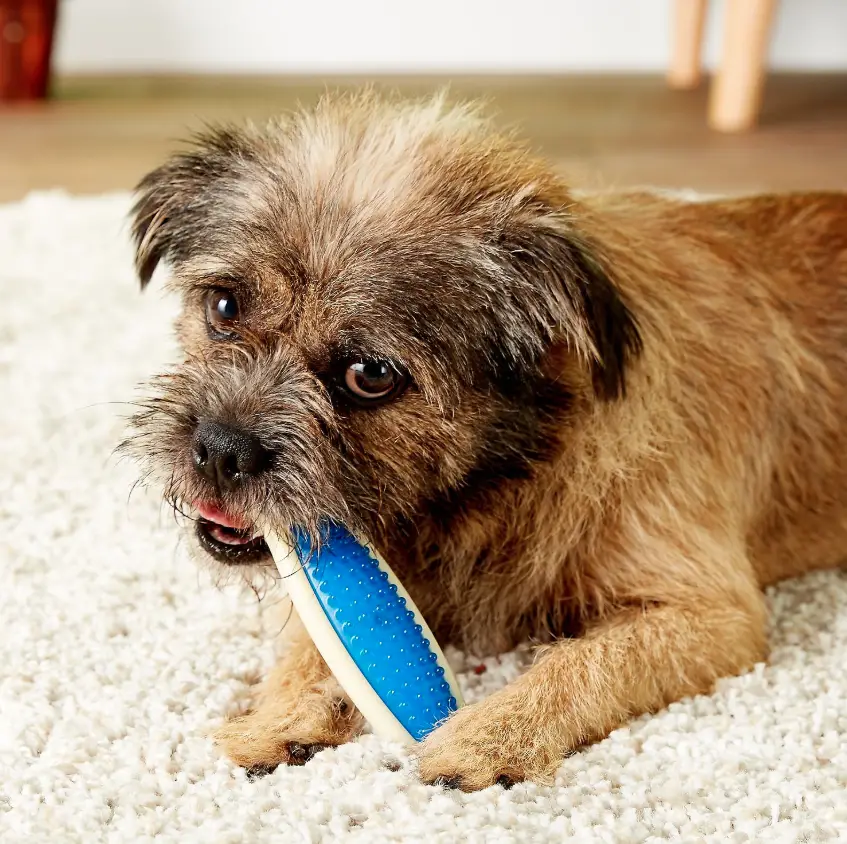
- Flavored stick to promote intentional chewing and dental care: Click this link to check the current price on Chewy

Please be mindful of toy sizes when you’re ordering online or purchasing in a store. The size of your puppy at the time you bring him home directly impacts the size of the chew toys he’ll need.
Regular Toys
Again, yes, there is a difference in regular toys for us and chew toys. They are structured differently, obtain texture gradations, and are utilized differently.
My favorite toy of all time is an ultimate classic. It’s a tennis ball. Every dog in every home needs a tennis ball. Especially if they’re retrievers or enjoying playing fetch.
Most puppies don’t fully understand the whole fetch concept early on – but fear not, this improves with extended amounts of play time.
I’ll link a bag of tennis balls below for ease of use as well as some other good puppy toys to have on hand.
- Bag of tennis balls: Click this link to check the current price on Chewy
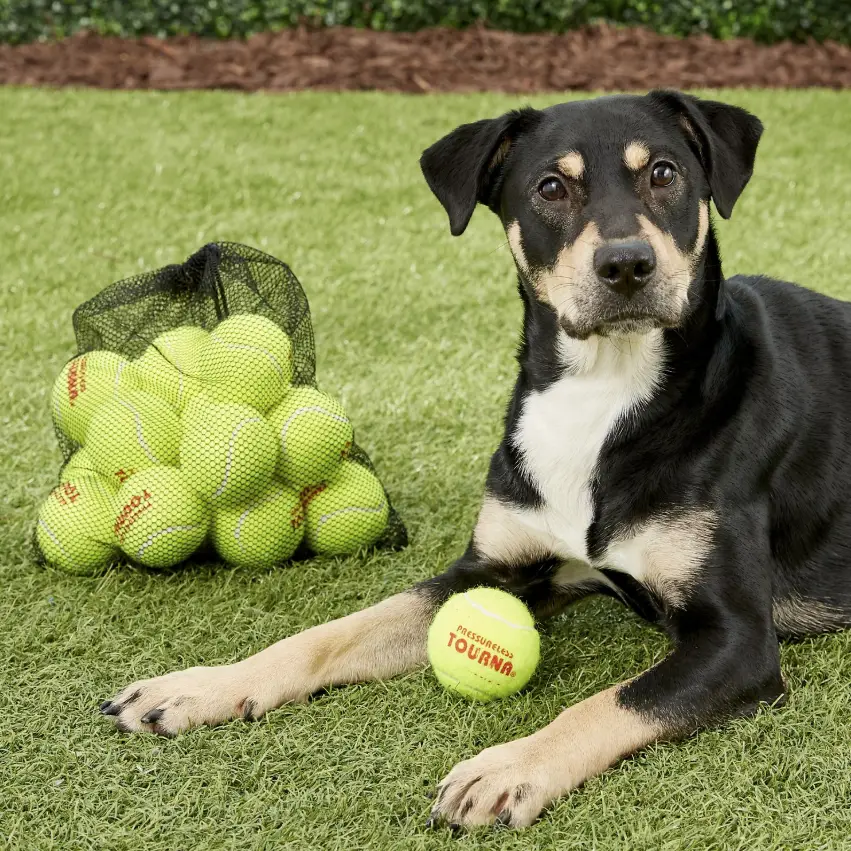
- Tug of war dumbbell dog toy: Click this link to check the current price on Chewy
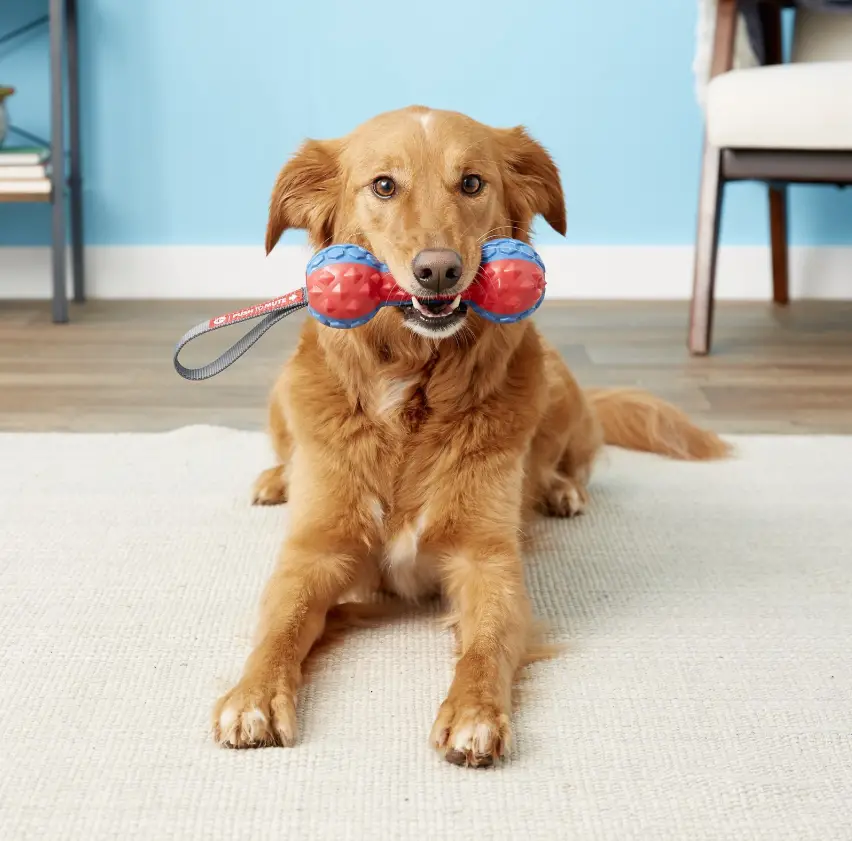
- Squeaker ball toy: Click this link to check the current price on Chewy
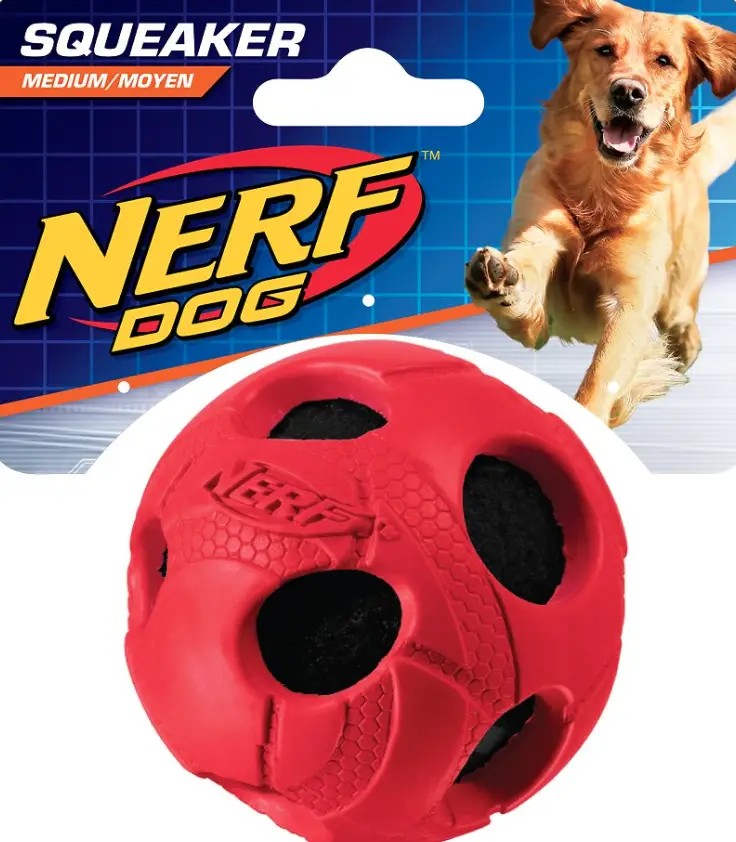
- Soft Frisbee dog toy: Click this link to check the current price on Chewy
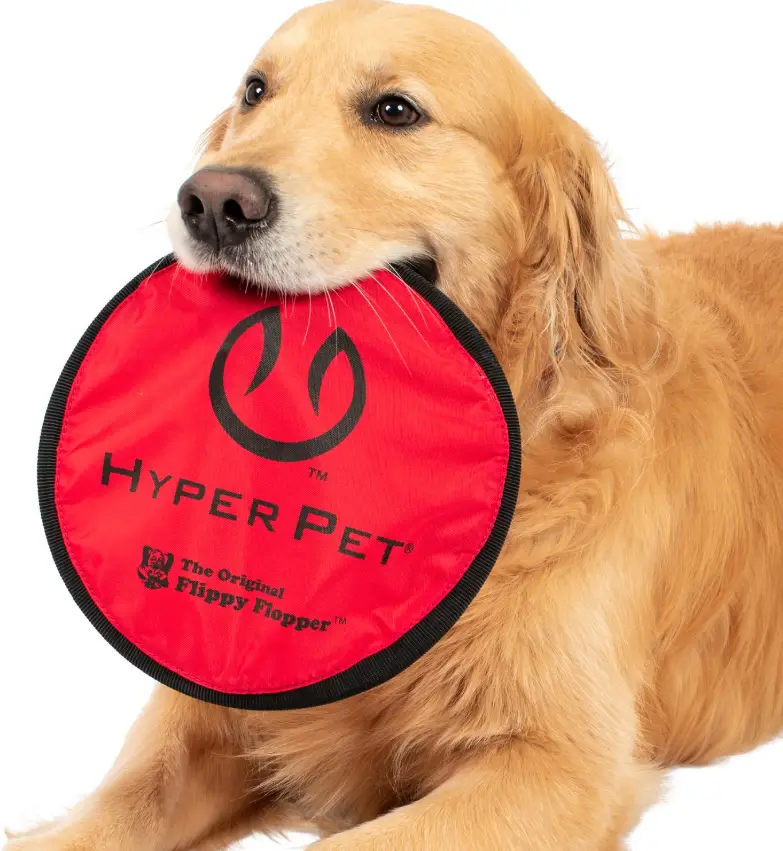
One of my favorite things to do is go to the store with my mom because she lets me pick my own toy. I realize we’re strictly speaking on proactive and preparation items at the moment – to be done prior to your pup coming home, but keep this in mind for later on down the road. We love doing this with our humans.
Also, sometimes you guys just pick out crappy toys.
ID Tags
You want the cheap and easy way?
Go to Walmart or PetSmart and use their machine for a quick dog tag solution. It gets the job done and works just fine.
However, if you want something a bit more sustainable long term, opt for a more heavy duty tag or get your contact information embroidered directly on your pups collar.
I’ve linked both options directly below:
- Qalo Silicone Dog ID Tags: Click this link to check current price on Qalo

- Personalized dog collar: Click this link to check current price on Chewy

Side Note: You may want to hold off on the personalized dog collar until your puppy is full size – that way you’re not having to reorder these on a quarterly basis. Perhaps start with the silicone or metal detachable tags.
Crate
Ah, the safe space.
The key to a successful crate experience is to size it appropriately. I briefly mentioned an adjustable crate that can be altered as your puppy grows.
The trick is to not have a huge wide open crate with too much room for your puppy to roam around. It defeats the intended purpose. Again, don’t stress, we like confined spaces like this.
My husky sister still insists on wedging herself under the bed. She barely fits but absolutely loves that space. She’s always under there listening to an old Mariah Carey CD or something. Who knows.
Anyway, I’ll link my favorite crate directly below for your shopping convenience:
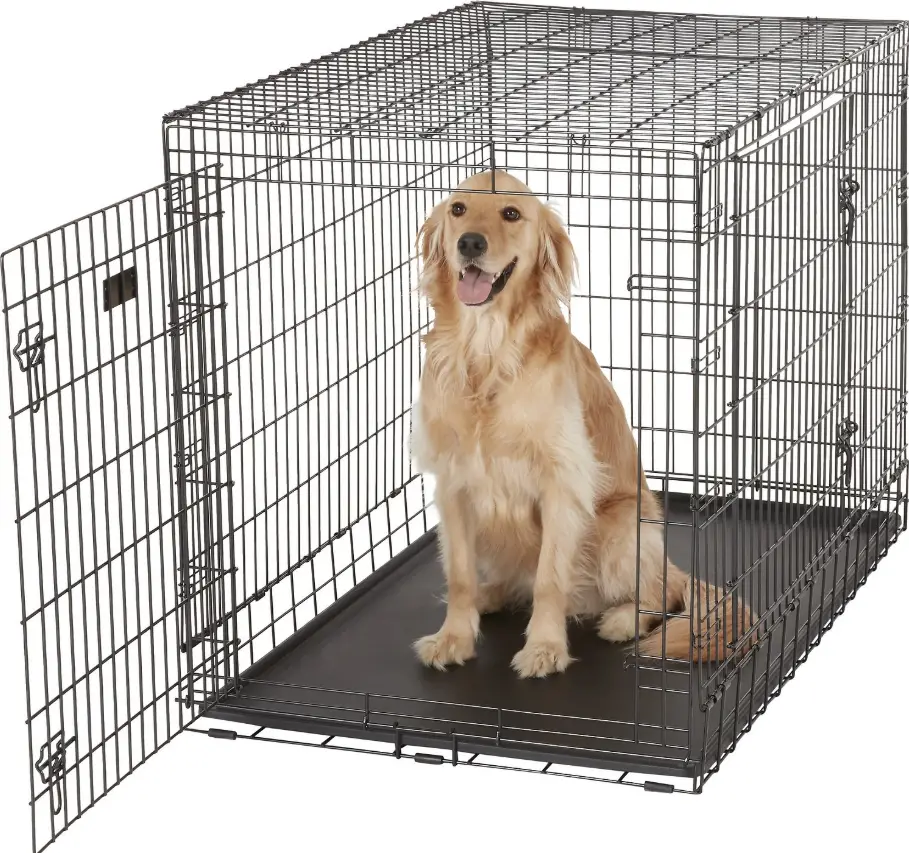
- This one comes with a divider panel you can use when your puppy is really small. It’s hard to see in the image of this one, but this detail is highlighted as a benefit in the description: Click this link to check the current price on Chewy
Crate Sizing Chart
| Your Dog’s Weight in Pounds | Crate Size |
| 0-30 lbs | 18″ x 24″ |
| 31-39 lbs | 24″ x 24″ |
| 40-49 lbs | 30″ x 30″ |
| 50-59 lbs | 36″ x 30″ |
| 60-79 lbs | 36″ x 36″ |
| 80-89 lbs | 48″ x 24″ |
| 90-99 lbs | 48″ x 36″ |
| 100-149 lbs | 60″ x 36″ |
| 150-180 lbs | 72″ x 36″ |
Stair Gates
This is a baby gate you can buy from almost anywhere. Nothing fancy required for the intended purposes.
Side note: they do make specific “dog gates” but I would love for someone to explain the difference between a dog gate and a baby gate. Identical.
The baby / puppy gate can be used to keep your new puppy from climbing and falling down the stairs, or used to keep them out of a certain room or area of your house until they’re better equipped to be trusted there – typically once they get a bit older.
Again, the brand doesn’t necessarily matter, but I’ll go ahead and link one directly below for your continued shopping convenience.
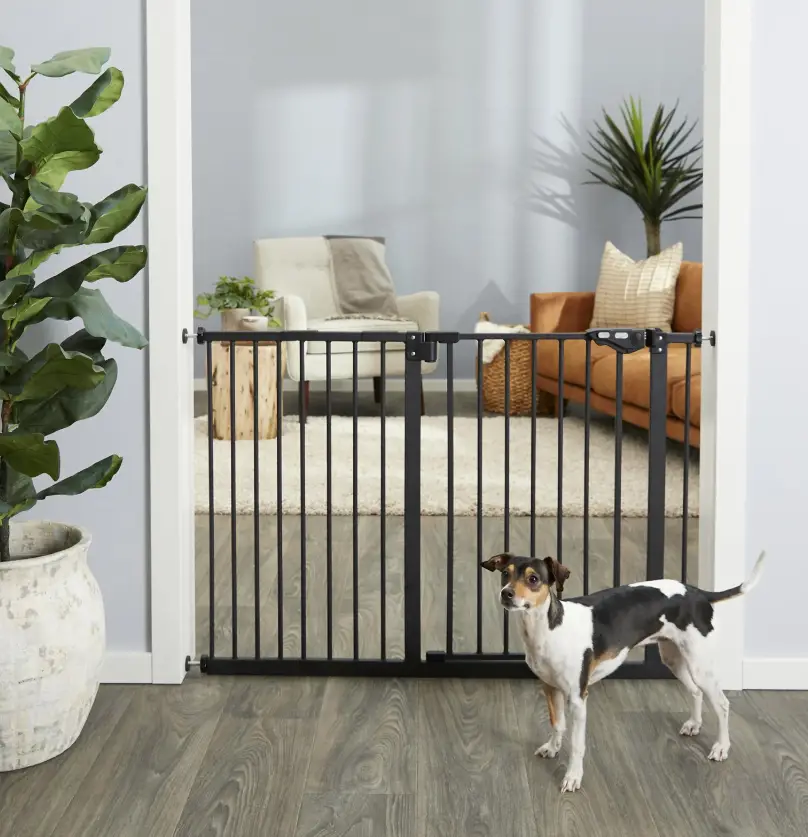
- Adjustable auto-close 30 inch pet gate: Click this link to check the current price on Chewy
Surviving the First 24 Hours
You. Will. Be. In. A. Heightened. State. Of. Stage. 5. Anxiety.
Fear not.
These increased levels of stress are completely normal. Remain calm, well, pretend to, at least. Just know that these feelings will subside after the first day (or two – or seven).
The length is up for debate.
The amount of time it takes a human to come down from their nerve wracking trip to puppy town is individualized, at best.
While the excitement of having a new puppy in your home will counter some of the anxious feelings, it won’t be enough during the first 24 hours.
This is the first time you will be experiencing the amount of work and care your new puppy will absolutely require.
Dog adoption is not for the faint of heart, but definitely worth it if you can stay focused and diligent about preparation and schedules. The easiest way to streamline your puppy on-boarding process is to be overly organized.
Shall we begin at the first hour?
The Car Ride Home
You’re officially in charge of this cute little ball of fur in this very moment. Did you come prepared? Do you have a little crate or travel carrier? Or a seat belt?
This isn’t something you should be thinking about while you’re walking out of the shelter with your puppy in your arms. This is something that should have been thought about prior to this moment in time.
Just ensure that you have something to provide a safe car ride home for your new puppy before the day you bring him home.
Simple as that.
New Home New Spaces
It is important that you remain conscious of and thoroughly understand that EVERYTHING is new to your puppy. This is the first time (if it truly is a puppy) that he’s ridden in a car.
This will be the first time he sees, smells, walks, and pees in your house. More on that pee part next.
Again, be patient with the house breaking part. Don’t overreact or hover or overwhelm your new baby. Let him walk around and experience his new home on his own terms. This will eliminate stressors and smooth the initiation process more than you can imagine.
Pro Tip: Let them roam around outside on the lawn for the first 15 minutes of being home. This will allow them time to do the pees and the poops and begin potty training on the right foot. Encourage this behavior with positive reinforcement when they do pee. This will help optimize the house training work flow that comes in to play next…
House Training 101
Take note that fully house training your puppy within the first 24 hours of bringing him home will not happen.
I repeat, it’s best to have ZERO expectations here.
The most important thing you can do is to be proactive in providing direction for your puppy.
What do I mean by that?
Simple.
Take your puppy out FREQUENTLY. This will be ridiculously annoying at first, but if you listen to me here and take him out every hour then he’ll begin to catch on rather quickly that his pees are meant to be taken in the grass outside.
If you’re a follower of my articles you hear me associate repetition with success a lot when it comes to dog training.
Repeat.
Then repeat.
Oh, and repeat.
But don’t forget to repeat the repeat.
The sooner you can get your puppy on a schedule, the better off you will BOTH be.
Crate Training 101
Start them in a crate immediately.
Get them use to their new crate. More than likely this won’t be their first time in one, but regardless introduce them as soon as possible.
Start by putting them in there with a cozy blanket and some toys. Leave the door open. Let them know it’s a safe place and not a cage to keep them locked up and away from time with you.
Slowly introduce them to the door being shut and you being out of the room for short bouts of time, periodically throughout the first part of the day.
The sooner you begin working on this, again, the sooner your pup will get use to the idea of it.
Open crate door.
Repeat.
The First Night
Buckle up, buttercup. You’re in for a doozy.
The first night with my parents was a breeze, but I was 10 weeks old and already a perfect boy.
My sister was another story.
We adopted her into the family when she was only 5 weeks old. She whined and cried and squeaked all night long.
My mom would set an alarm to take her outside to potty at 12am, 2am, 4am, and then when she would get up for work.
This was exhausting. I wasn’t used to this.
While I can’t say that ALL puppies will need this type of night schedule to house break them, I will say that it speeds things along.
Pro Tip: If you choose to roll the dice and attempt to sleep through the whole first night, be sure to keep an ear out for your new puppy. If they start to cry, this may mean they need to do the pees or poops. I know you’re going to be tired, but don’t lose your patients with them.
Your new puppy is scared, has no clue what’s going on, misses their dog mom, and oh buddy do they have to pee.
Be the calming factor in their life.
And good luck with your first sleep.
Puppy Regret
And here we go….
It’s right about now that the ol’ Puppy Regret begins to settle in. You won’t want to say this out loud initially. I mean, come on, how could you? It hasn’t even been a week yet and you’re already wanting to give that thing back to where it came from.
I get it. Trust me. We’ve all been there. I wanted to give my husky sister back within the first 4 days. She smelled so weird and kept biting my ears. I didn’t love this.
Please hear me when I say you’re not a bad person for having this thought flow through your mind.
You’re sleep deprived, had a proverbial dog wrench thrown into your spokes, your daily routine has taken a major hit, and you’re suddenly in charge of a tiny precious demon thing.
We get it.
But, you can do this.
Puppy’s are a lot of work and take levels of patience that would drive a priest to throw rocks at people.
I need you all to know that puppy regret is an inevitable realization that you will absolutely experience at some point in time shortly after you bring your new puppy home.
Know this now so that you’ll be a bit more prepared for this overwhelming rush of emotions when they come.
If you go through with your decision to adopt your puppy then hold firm during this puppy regret. This too shall pass.
If you don’t think you can handle the mental wreckage that takes place within the first 7-30 days of owning a puppy then please, I beg you, perhaps reconsider a puppy at this time.
Learning to Live with Each Other
What does this look like? Well, it depends on your current situation. Do you have human children? Do you have a good grasp on puppy socialization? What are your on-going plans for continuous and scheduled puppy exercise? Do you have any other animals?
You know what, let’s just jump right in, assuming that any of the questions mentioned above do in fact pertain to you specifically.
Integrating Your New Puppy with Your Human Child
I want to make sure you’re listening to me right now in this very moment.
Do I have your full and undivided attention?
Okay.
ALL of the work needs to fall on the shoulders of your human children.
Let me rephrase that.
ALL of the work needs to fall on YOU (the parent of the human children) to teach your spawn that this new puppy is a living, breathing, sentient being, who is not to be hit, kicked, thrown, or bitten.
Ever.
Kids can be bananas. Trust me. I’ve had my fair share of run ins with these tiny little drunk people.
These little humans can be the most terrifying or the most terrific things to ever happen to a puppy. You make the choice by the way in which you teach us both to be around each other.
We want to love your human kids and grow up with them. This kind of bond is enigmatic and miraculous. Trust me. You want this for your kids.
Just use words like “be easy” a whole whole lot. Oh, and make sure you monitor interactions as closely as possible. Especially in the beginning.
I’m not trying to scare you – just to make you hyper aware.
When Should I Socialize My Puppy?
Well, will you look at that?
I have an entire post dedicated to this one single question.
If you want to go a bit deeper down the socialization rabbit hole then click this link and hold on.
If you want a brief synopsis on the socialization topic, then stick around here and read this instead:
- Socialization starts NOW. Your puppy is getting to know you and you’re getting to know your puppy. This is socialization 101. Everything else stems from this initial precedence set here first.
- Supervise ALL social interactions. Dogs can be finicky little creatures and picky about who they want to spend their time with. Don’t let them get stuck somewhere with someone who doesn’t like them or vice versa.
- Do NOT force socialization. Let this occur naturally. This is an innate behavior that comes with time. Patience, humans.
Puppy Exercise Schedule
I cannot begin to explain to you just how important a regular exercise schedule for your pup is to maintain.
This. Is. Everyting.
Do you want an easy to deal with and perfect puppy?
Okay. Then make sure they get enough exercise to where they’re not bat cat crazy and need to run through a wall and eat all the human shoes.
This also helps your pup sleep at night. Don’t worry, I’ve outlined all of that for you to read up on here if you’re at all interested.
The common denominator is always…. ROUTINE.
Don’t get lazy. Stick to the routine of at least 20-30 minutes of exercise every single day. I’m mostly talking about your pup here, but it wouldn’t hurt for you to get the blood pumping, either.
Start off slow at first. Especially depending on the age and size of your puppy. Progress continuously in exercise intensity and frequency as your puppy ages.
Just stay consistent with it.
For the love of all that’s calm and easy to deal with.
Other Animals?
Oh boy. This one can be tricky. But it doesn’t necessarily have to be.
It’s important to tread lightly, be vigilant, proactive, and attentive in the initial stages of introducing your new puppy to an older puppy or grumpy cat.
Yes, I realize not all cats are grumpy, but come on, they have a grumpy face and attack beams of light on the wall like freaky little ninjas.
I don’t trust them. And yes, we can communicate with cats. Read this if you don’t believe me.
I digress.
The single most important thing that you can do to ensure the best possible outcome when introducing an existing pet to your new puppy is to REMAIN CALM.
We sense your fear and have a nose for anxiety. Guess what? It makes us frightful and anxious when you feel these things.
So please… chill.
Important: Bring your existing pet into the same room as your puppy. This will make your older pet feel less threatened if you do it this way versus bringing a new puppy into the older pets current domain.
Don’t force them in each other’s face. They will be curious of each other here so let the sniffing party commence.
Watch them closely but don’t be paranoid. Your current pet will most likely not love the fact that you brought a new puppy home with you, but I promise they will come around.
Here’s this word again – stay consistent and routine with their interactive exposures and your supervision.
Oh, and good luck. 🙂
Taking Care of Your Puppy
I have a saying: if you’re not going to spoil us and love us then leave us alone.
What I mean by that is we deserve to be a part of your family, not a supplemental toy that loses it’s shine after the first couple of weeks. Taking care of your puppy is a commitment that will last the rest of our lives. You can never stop taking care of us.
But what does this actually look like?
Feeding Your Puppy High Quality Food
I know we briefly touched on this up above, but I cannot stress the importance of feeding your puppy high quality food.
Skip on the cheap kibbles. This stuff is disgusting and does bad things to our bodies over time.
Either cook your dog’s food or purchase high quality food from a supplier like Chewy or Ollie or The Farmer’s Dog.
Starting your puppy on a regimented eating schedule is also important. Start by following these basic meal guidelines:
- Puppies 5-15 weeks old: 3 meals per day (unless they’re a tiny breed, then add in a 4th meal)
- 6 months old: 2-3 meals per day
- 7-12 months old: 2 meals per day
These are generalized for simplicity – start here but observe your puppies behavior and adjust accordingly.
Potty Training
Again, you should already be doing this from the moment you bring your puppy home. But NEWS FLASH – it doesn’t stop there.
Potty training your puppy will be an ongoing routine.
Did you catch that?
I said ROUTINE again.
Dogs are schedule driven. Meaning we love a good routine. It keeps things consistent and helps us understand the way of our humans.
A good routine helps make a well behaved dog. Effective and efficient potty training is no different.
Be sure you’re taking your puppy out at the exact same time under the exact same circumstances every single day in the beginning. 30 minutes post meal, immediately upon waking, immediately after crate time, and immediately before bed.
There will inevitably be other times when your puppy will need to potty, but this is a good schedule to start with for now.
Understanding Puppy Teething Mentality
Fun Fact: Puppies are born without any teeth and will typically have a full set of baby teeth at around 6 weeks old.
You puppy will lose his razor bladed baby teeth (these things are so sharp) and gain his adult set relatively early on in the puppy process.
But what does that look like?
- Nipping and biting at your hands and arms (this is completely normal but hurts like a…)
- Your puppy will need to chew during this teething time to help soothe his gums. If you don’t have adequate toys available, your flip flops may end up as the unintended victim.
- Teeth are vital to a canine’s overall development. Pay attention to your puppy’s teeth and the progressive evolution of losing his baby ones and gaining his big boy set. If anything looks abnormal, consult your vet immediately.
Getting Your Puppy Fixed
Spay and neuter recommendations typically fall between the ages of 5-6 months.
I’m a boy, so I don’t have this problem, but our vet told my parents to let Callie (my sister) go through one heat cycle before they got her fixed. He said that this would allow for her lady parts to fully develop on the inside and rule out the typical side effects that have a tendency to come with spaying a female too soon.
All dogs are absolutely wonderful. Humans don’t deserve us. However, taking the responsibility to get your pup fixed eliminates the chance of another puppy ending up in a shelter, begging to be adopted, or worse…
Maintenance
Your puppy will never not need you.
As a matter of fact, the older they get, the stronger the bond will grow thus intensifying the need to interact and love you on a daily basis.
Give your pup all the attention he needs and continue to pet and smooch all over them. By rubbing on them constantly and being an integral part of their lives, you will be better positioned to notice if anything is off or unusual with your pup – this gives you a chance to catch certain things early on or rule out any issues that may cause you unwarranted stress.
Overall, the best way to take care of your puppy is to shower them with love and affection.
We’re simple creatures. Don’t over complicate the process too much.
Mistakes You Will Absolutely Make
You’re human – of course you’re going to make mistakes. And that’s okay, as long as you continue to learn and adapt as a result.
Let’s take a look at some of the more obvious mistakes made so we can attempt to get ahead of this crazy curve.
Putting Training Off Until “He’s a little Bigger”
No. Nope. Nada. So much no to this.
The sooner you begin initiating commands and training protocols, the better.
Why wait?
By teaching your puppy basic skills immediately, you’re giving them a leg up on the more advance training techniques that come next.
Begin with “sit”, “stay”, “touch”, and “down”.
Reward good behavior with tiny treats and lots of love.
Not Crate Training
Do not drop the ball here, people. Crate training is so important to the well being and safety of your pups, as well as the safety of your home and valuable possessions when you’re gone.
Make sure the crate fits the size of the puppy – too large and they’ll have room to poop in the back and sleep in the front. Too small and well, it’s too small.
The crate should be tall enough for them to stand up in and perfectly long enough for them to turn around in if need be.
Try to never leave your pup in the crate for longer than 6 hours at a time.
Fussing Well After the Crime Was Committed
Listen humans. We’re very smart creatures, but if we accidentally chew on a delicious piece of garbage you left in the trash can as soon as you leave to go to work, don’t come prancing in 8 hours later yelling and swinging your crazy finger at us.
Because guess what? We’ve already forgotten – let’s just move on.
What you can do instead: You can grab that piece of trash, show us, then say “NO” in your firm scary voice.
Okay, now let’s move on.
This is also very important when you puppy pees or poops in the house. Don’t yell at them once it’s done. Want to know what that does? Makes them scared to ever pee or poop because you yelled at the poop.
Make sense?
Oh, and while we’re on the potty topic, NEVER rub your puppy’s nose in their pee. That’s just gross and teaches us nothing.
Don’t be gross.
Not Establishing a Routine
How many times do I have to tell you how important a routine for your puppy at any age is?
Critical. Vital. Imperative. Crucial. DO IT.
A set routine gives your dog a peace of mind.
They know you’ll come home. They know you’ll take them out. And they know you’ll feed them.
Why?
Because routine, that’s why.
Not Puppy Proofing Your Home
For the love of sweet potato flavored peanut butter treats do NOT forget to do this.
Puppies are nosey.
They’ll be into everything they can possibly find. Make sure you have cleaners and other toxic chemicals locked up and completely out of puppy reach.
This puppy proofing also calls for removing remotes, plants, shoes, clothing, children’s toys, etc, up off of the floor.
Get on the floor. Go ahead, lay down there big fella. What do you see? All those things pose a potential threat to your puppy. Take care of them now.
Hitting
You can’t be serious?
Is this sub header even necessary?
Okay.
I’ll leave you with this bit of advice:
DON’T EVER HIT YOUR PUPPY. EVER.
End of story.
Conclusion
Whew doggies.
If you’ve made it this far then please accept my dog paw fist bump. I commend you, fellow dog scholar. You are worthy.
I realize this was a lot of information. Trust me. It took me two weeks to put all of this together for you. You better appreciate my time commitment. I could have been napping instead.
Anyway, I hope this can be something that you can use as a continued resource throughout your puppy contemplation. I also hope this can be a reference you can revisit at various times during your puppy parenting longevity.
I’ll leave you with this…
Good luck, humans. We’re all rooting for you.
And as always, continue to Live, Love, Laugh, and Scratch our bellies often.
Love you guys,
JTB
This article has been reviewed by our Editorial Board and has been approved for publication in accordance with our Editorial Policies.
